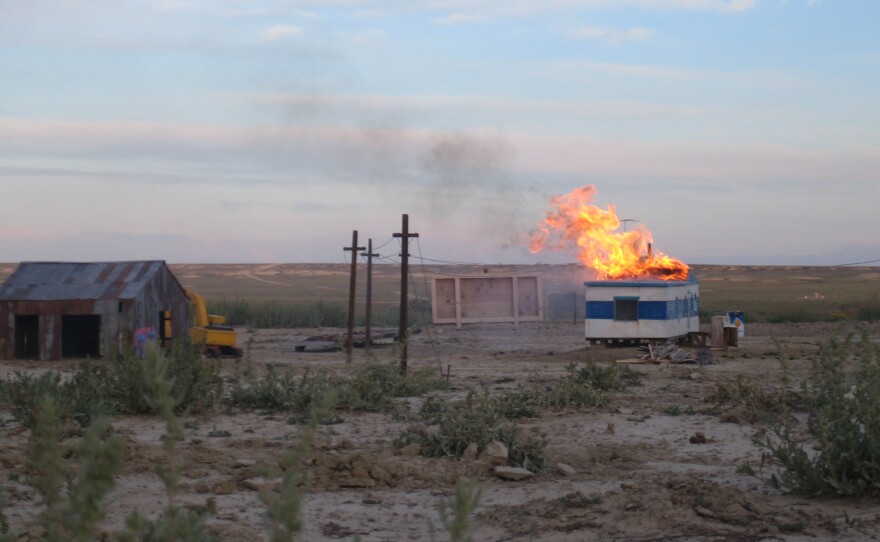When you think of Wyoming landscape art, it's probably not of fracking sites or abandoned man camps. But two Laramie artists feel it’s time to take a hard look at all of Wyoming’s landscapes. My artist husband and I decided to camp out with painter Pat Kikut and mixed media installation artist David Jones at their desert studio, somewhere north of Wamsutter.
To get there, we drove through miles of gas fields and I wondered, how did they even discover this spot? Jones and Kikut say they came exploring the area for a project for the Berry Biodiversity Center at the University of Wyoming.
“That was three years ago and there were grants that were combining biodiversity and art. And so we had this idea of exploring life zones of the Red Desert.”
Driving the miles of oil and gas roads north of Rawlins, they found an oasis.
“It's funny,” Kikut says, laughing, “we were looking for habitat, we found habitat and now we've created habitat. Including horseshoe pits.”
Their campsite sits on a cliff overlooking a natural artesian well. Ducks paddle here. Hawks wheel above. We saw a large herd of desert elk migrate while we were there. And all around, natural gas pumps and tanks sit idle.
“There's definitely times when you come out here and there's lots of drilling activity,” Jones says. “And then there's times when there's none. And right now actually, there are, I noticed there's at least three new wells going in.
Jones says they never know if they'll show up and find a new well in their campsite. But they both find inspiration in the sheer size of such industrial sites.
“They're pretty similar in aesthetic with some earthwork sculpture,” he says. “Maybe that's my interest too is the scale. They don't look that big from the road but when you actually walk around on one of those sites, they're huge. Huge holes.”
Kikut says it's important that artist don't turn a blind eye to such landscapes. He says, art has the power to change perceptions.
“It definitely has the ability to change people's approach to how the land is used and what the value might be.”
But today their work isn’t about industrial sites. Today, both artists are waiting for the moon to rise.
But for different reasons. Kikut the painter is close to finishing a series of 31 paintings he’s doing of the moon’s phases.
“At my studio at my home, there’s 30 of them. They are all arranged in a grid, but they read like a calendar of the moon.
Meanwhile, installation artist Jones hopes to film the moon rising through the window of a miniature mobile home he built. Inside the toy-sized trailer is a mini heap of trash bags, a mini heavy metal band poster on the wall, and a mini chair and coffee table. He built the 53-inch trailer after noticing lots of abandoned mobile homes littered around the Red Desert.
“And you always kind of find yourself asking yourself the question, how did this happen? What's the story? Because you don't know what the story is, your brain thinks the worst possible scenario.”
Inside the 1964 Avion travel trailer the artists use for shelter, Jones gets out a laptop and shows the movie he filmed on location of burning the toy-sized trailer down.
“I had some cannon fuse,” he says and we all laugh. “I just lit it and ran around the corner and hit record.”
“Am I hearing some sound effects?” I ask.
“Yeah, there's firecrackers behind these windows in little sticks that I super glued in.”
But Jones still needs one more thing to call the project done: a film of the moon rising through the window. While the artists wait for the moon, they head to the horseshoe pit.
“There's a rhythm to it that I don't think either of us have ever talked about,” Jones says. “Over the course of the day it’s like, okay, you get up you go to the bathroom, get coffee. And then at some point, we part ways and I go over here and do this and Pat’s over here drawing or painting. Cocktail hour is pretty important. A horseshoe game is pretty important.”
And they always cook a pot of carnitas over the fire.
But tonight, that routine is interrupted by the moonrise. In all that emptiness, it's a major event, like fireworks going off. Especially this one, huge and red from the smoke of distant wildfires. Kikut hurries out to his blank canvas. He wants to capture that rusty color.
“It's kind of fun to start paintings here because deep down in whatever I finish with it, it's got some of the Red Desert DNA in it as a layer.”
But things aren't going as smoothly for Jones and his mobile home. The moonlight isn't bright enough to show up on his camera as it takes photos once a minute.
“I wish there were an easier way to figure this out,” he says. “It's kind of the hard part of coming out here. You build this in the shop and you bring it here. Think it'll work. Sometimes it does.”
And it does work. The next morning, Jones shows us the stop motion video on his laptop. He has months more editing of his film ahead. But he has his last piece…a big red moon rising through the window of an abandoned mobile home, somewhere north of Wamsutter.












